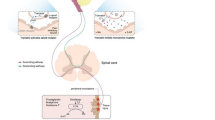Summary
Numerous clinical trials have shown etodolac to be an effective analgesic. The purpose of the present report is to review results of 14 studies that demonstrate the effectiveness of etodolac in a variety of painful conditions. Presented are the results of four postsurgical pain studies, one study of acute gouty arthritis and nine studies of acute musculoskeletal disorders: acute low back pain, acute painful shoulder, tendinitis and bursitis, and acute sports injuries. A single oral dose of etodolac (25, 50, 100, 200, or 400 mg) was compared with aspirin (650 mg) or a combination of acetaminophen (600 mg) plus codeine (60 mg) for the relief of pain up to 12 h following oral, urogenital or orthopedic surgery. In multiple dose studies of acute gouty arthritis and musculoskeletal conditions, etodolac 200 or 300 mg twice a day (b.i.d.) or 200 mg three times a day (t.i.d.) was compared with naproxen 500 mg b.i.d. or t.i.d., diclofenac 50 mg b.i.d. or t.i.d., and piroxicam 20 or 40 mg once a day (o.d.) administered over 5 to 14 days. The efficacy of etodolac was at least equal and in some ways superior to aspirin and acetaminophen plus codeine in the relief of postsurgical pain. In studies of acute gouty arthritis, significant improvement from baseline were seen for all efficacy parameters evaluated for both the etodolac- and naproxen-treated patients. All the present studies of musculoskeletal conditions have shown etodolac to be effective and comparable in analgesic efficacy to naproxen, diclofenac or piroxicam. In summary, etodolac therapy for pain following surgery, in acute gouty arthritis and in acute musculoskeletal conditions resulted in analgesia comparable to that provided by several well-established analgesic or anti-inflammatory agents.
Similar content being viewed by others
References
Bacon PA (1990) An overview of the efficacy of etodolac in arthritic disorders. Eur J Rheumatol Inflamm 10: 22–34
Gaston GN, Mallow RD, Frank JE (1989) The efficacy of etodolac compared with aspirin and placebo in patients with pain following oral surgery. J Oral Maxillofacial Surg 42: 362–366
Hutton C (1983) The effectiveness of 100 and 200 mg etodolac, aspirin, and placebo in patients with pain following oral surgery. Oral Surg 56: 575–580
Friedrich E (1983) A comparison of etodolac (Ultradol®) with aspirin and placebo in patients with episiotomy pain. Curr Ther Res 33: 100–107
Russell A (1983) Twelve-week study of etodolac, aspirin, and placebo in patients with rheumatoid arthritis. Clin Ther 5: 436–444
Edwards W (1983) Etodolac, aspirin, and placebo in patients with rheumatoid arthritis: a 12-week study. Clin Ther 5: 495–503
Gordon GV, Polsky BG (1983) Three-month trial of etodolac (Ultradol®) compared with aspirin and placebo in patients with rheumatoid arthritis. Curr Ther Res 33: 89–99
Andelman SY (1983) Etodolac, aspirin, and placebo in patients with degenerative joint disease: a twelve-week study. Clin Ther 5: 651–661
Sanda M, Collins SH, Mahady J, Hutz J, Krantz K (1983) Three-month multicenter study of etodolac (Ultradol®) in patients with osteoarthritis of the hip. Curr Ther Res 33: 782–792
Nelson SL, Bergman SA (1985) Relief of dental surgery pain: a controlled 12-hour comparison of etodolac, aspirin, and placebo. Anesth Prog Jul/Aug: 151–156
Versichelen L, Bilsback P, Rolly G, Merlo, Joubert L (1983) Etodolac in post-surgical pain: double-blind dose-ranging efficacy study with aspirin and placebo. Int J Clin Pharmacol Ther Toxicol 20: 236–239
McCarty DJ (1985) Arthritis and allied conditions. A textbook of rheumatology. Lea and Febiger, Philadelphia, Pa, pp 1282–1283
Neuman RG, Wilson BD, Barkley M, Kimball ES, Weichman BM, Wood DP (1987) Inhibition of prostaglandin biosynthesis by etodolac. I. Selective activities in arthritis. Agents Actions 21: 160–166
Lynch S, Brogden RN (1986) Etodolac. A preliminary review of its pharmacodynamic activity and therapeutic use. Drugs 31: 288–300
Brogden RN, Heel RC, Speigh TM, Avery GS (1979) Naproxen up to date: a review of its pharmacological properties and therapeutic efficacy and use in rheumatic diseases and pain states. Drugs 18: 241–277
Wallace SL, Singer JZ (1988) Therapy in gout. Rheum Dis Clin North Am 14: 441–457
Zvaifler N (1989) A review of the antiarthritic efficacy and safety of etodolac. Clin Rheumatol 8: 43–53
Jacob G, Messina M, Caperton E, Gordon R, Harris G, Sack B, Vreede P, Weitzman R (1985) Safety and efficacy of etodolac, once or twice a day, in the treatment of active rheumatoid arthritis. Curr Ther Res 37: 1124–1129




